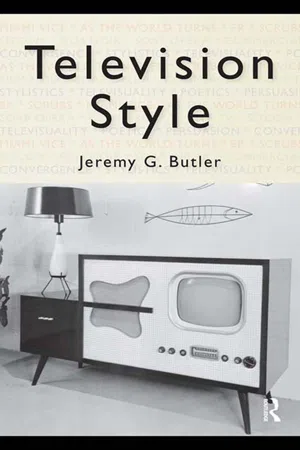1.
Television and Zero-Degree Style
It is commonly presumed—especially among film scholars—that daytime soap operas have no style, that their harried production schedule does not permit the luxury of stylistic embellishments. How could it when soap-opera production companies must churn out 30–60 broadcast minutes five days a week, with no breaks for holidays and, more significantly, with no reruns? But this attitude toward style views it as something extra that is added to a television program, an accouterment that might aid the signification process but is not central to it. In this book, I have argued that all television texts have a style born of a confluence of economic necessity, industry trade practices, aesthetics, and network standards. In this context, soap opera becomes a particularly interesting test case, because it illustrates narrative-television production under extreme time constraints. In a sense, it is narrative production without pretense, designed to present the maximum amount of narrative as efficiently as budget, time and technology will allow. Analyzing soap-opera style offers an opportunity to examine Caldwell's “zero-degree style,” to see just how efficiently diegetic spaces may be constructed.1
Soap opera analysis is also important because of its position in media studies at the end of the twentieth century. At the time, the study of television soap opera lured scholars from cinema studies, myself included, to consider how melodrama might cross over from one medium to another. Film melodrama as a genre and directors such as Douglas Sirk, John Stahl, and Frank Borzage attracted heightened interest in the late 1970s. Feminists were particularly interested in unpacking the ideology of the “woman's picture.” Several of these film scholars subsequently became interested in the equivalent television genre—the soap opera.2 Consequently, soap opera was the first television genre to receive sustained attention from cinema scholars. In the 1980s critical commentaries on soap opera's narrative structure—modeled on cinema studies and literary criticism—became as commonplace as child custody conflicts in the genre itself.
In Charlotte Brunsdon's assessment of “The Role of Soap Opera in the Development of Feminist Television Scholarship” (1995) she incidentally chronicles the vanguard role of feminist film theorists in the deconstruction of television soap opera as a signifying system.3 The work done by feminist television scholars up until that time, she maintains, can be grouped into four categories: 26
- Studies of the position of women within television industries.
- “Content analyses”—as they are called within the tradition of mass-communication research—of women in soap opera programs.
- Considerations of the soap opera as semiotic text.
- Research on soap-opera viewers and their relationship to the text.4
Of these four, textual studies has the greatest pertinence to stylistic analysis. Tania Modleski's relatively early (1979) essay, which sparked much of the feminist rethinking of the genre, is typical of this approach.5 She contends that soap opera may prove to be the most (only?) feminist television form. Invoking Roland Barthes’ hermeneutic code, Modleski sees feminist potential in three aspects of the soap opera: its disrupted narrative form, its avoidance of narrative closure, and its construction of a fragmented spectatorial viewpoint. Consequently, her argument is not concerned so much with what might be called a feminist television style of sound and image, but with a feminist form of narrative actions (and the feminine spectator's relationship to that form). She thus spends very little time on the actual use of sound and image. Modleski shares this concentration on narrative structure with many of the textual-studies writers drawing on literary and cinematic analytical traditions. The idea of an endless story has captivated those accustomed to narrative closure, largely because narrative aperture—the open text—is a trait normally associated with modernist or progressive texts, not forms of popular culture as seemingly conservative as soap opera. Ellen Seiter, for example, comments on the significance of soap opera's eternally disrupted and eternally reconstructed narrative:
The importance of small discontinuous narrative units which are never organized by a single patriarchal discourse or main narrative line, which do not build towards an ending or closure of meaning, which in their very complexity cannot give a final ideological word on anything, makes soap opera uniquely open to feminist readings.6
This feminist concern with ideological paradoxes in soap opera narrative dominated the reevaluation of the genre in the 1980s and the emphasis on narrative form persists to the present day in textual studies.7
By the turn of the century, soap-opera analytical work could be found in publications as diverse as the Journal of Employment Counseling and Screen—much of it from a feminist perspective.8 Moreover, as Brunsdon chronicles in The Feminist, the Housewife, and the Soap Opera (2000) and Louise Spence reviews in Watching Daytime Soap Operas: The Power of Pleasure (2005), feminist work on soap opera in the late twentieth century was dominated by new, ethnographic, audience-oriented research.9 Central to our concerns, most of this audience-oriented work took for granted the positioning of the spectator through sound and image, through style. These studies rarely, if ever, asked their interviewees for their opinions about the characteristics of soap-opera videography, mise-en-scène, or sound design. Further, in textual-studies work that was done during this time, narrative form was the primary draw and little attention was paid to the work of image-sound style in the construction of these never-ending narratives. To date, there has been no comprehensive study of soap opera as a system of signification, a text of sound and image constructed in a highly conventionalized fashion.10
Sampling the Ever-Expanding Text
To begin this work, the detailed analysis of the soap-opera text is necessary, but it quickly becomes obvious that this text is enormous and ever-expanding. Consider As the World Turns (commonly abbreviated as ATWT). Its continuing narrative text began at 1:30 p.m. EST on April 2, 1956 and has since broadcast over 13,000 episodes. Taking into account its expansion from 30 minutes to 60 minutes on December 1, 1975 and its approximately 250 annual episodes,11 we can estimate that over 11,000 hours of broadcast time have been generat...
